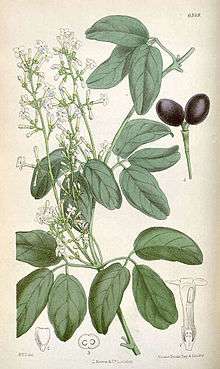Harriet Anne Thiselton-Dyer
Lady Harriet Anne (Hooker) Thiselton-Dyer (1854–1945) was a British botanical illustrator.


Life and career
Harriet Anne Hooker was born in 1854 to the botanist and explorer Joseph Dalton Hooker and Frances Harriet Henslow, who was the daughter of botanist and Cambridge University professor John Stevens Henslow. In 1877 she married the botanist William Turner Thiselton-Dyer (later knighted), with whom she had a son and a daughter.[1]
Thiselton-Dyer belonged to a generation of English women who developed their interest in botany into professional careers.[2] She studied with the noted botanical illustrator Walter Hood Fitch, who was the lead artist for Curtis's Botanical Magazine. After Fitch resigned from the magazine in 1877 following a dispute with her father—for whom Fitch had been preparing illustrations for several books—Thiselton-Dyer stepped in.[3][4] She rendered almost 100 illustrations for publication during the period 1878–1880, helping to keep the magazine viable until Matilda Smith took over as lead illustrator.[5]
In 1894–95, Thiselton-Dyer painted some 550 copies of Brazilian botanist João Barbosa Rodrigues's orchid paintings, which had been lent to her by the botanist Alfred Cogniaux, who was using some of them to illustrate a work on Brazilian flora.[6] Unfortunately, the original drawings disappeared in Brazil sometime after Rodrigues's death and are now lost, making Thiselton-Dyer's copies—housed at Kew Gardens—a uniquely valuable resource on Rodrigues's work. In 1996, some of these copies were published to accompany an article on Rodrigues that appeared, fittingly enough, in Curtis's Botanical Magazine.[7]
Thiselton-Dyer was also known as an accomplished gardener.[8] In 1905 the Thiselton-Dyers moved to the Cotswolds. When her husband died in 1928, Harriet moved to Devonshire, where she died in 1945.[5]
In 2013, Thiselton-Dyer's work was included in the exhibition "The Feminine Perspective: Women Artists and Illustrators" at the Chicago Botanic Garden, alongside work by Henriette Vincent, Ellen Robbins, and others.[9]
References
- ↑ "Thiselton-Dyer, William Turner". Complete Dictionary of Scientific Biography. 2008
- ↑ Gaze, Delia. Concise Dictionary of Women Artists. Routledge, 2001, p. 63.
- ↑ "Early New Zealand Botanical Art: Matilda Smith (1854-1926)". University of Wellington website. Accessed 2015-08-17.
- ↑ Hemsley, W. Botting. "The History of the Botanical Magazine 1787–1904". In Index to the Botanical Magazine. London: Lovell Reeve & Co., 1906, pp. v–lxiii.
- 1 2 Kramer, Jack 1996. Women of Flowers: A Tribute to Victorian Women Illustrators. New York, Stewart, Tabori & Chang. ISBN 1-55670-497-6
- ↑ Mori, Scott A., and Flora Castaño Ferreira. "A Distinguished Brazilian Botanist: João Barbosa Rodrigues (1843–1909)". Brittonia, 39:1 (1987), pp. 73–85. [N.B. Ferreira is Rodrigues's great-granddaughter.]
- ↑ Cribb, Phillip, Samuel Sprunger, and Antonio Toscano Brito. "The Orchid Paintings of João Barbosa Rodrigues (1842–1909)." Curtis's Botanical Magazine 13.3 (1996): 152-157.
- ↑ Kramer, Jack 2002. The Art of Flowers. New York, Watson-Guptill Publications. ISBN 0-8230-0311-6
- ↑ ArtPlantae. "The Rise of Women as Botanical Illustrators". ArtPlantae Today, Aug. 14, 2013. (Website.)
Further reading
- Desmond, Ray, ed. Dictionary of British and Irish Botantists and Horticulturalists Including Plant Collectors, Flower Painters and Garden Designers. CRC Press, 1994.
- Ogilvie, Marilyn Bailey, and Joy Dorothy Harvey. The Biographical Dictionary of Women in Science: L-Z. Routledge, 2003, pp. 1278–79.